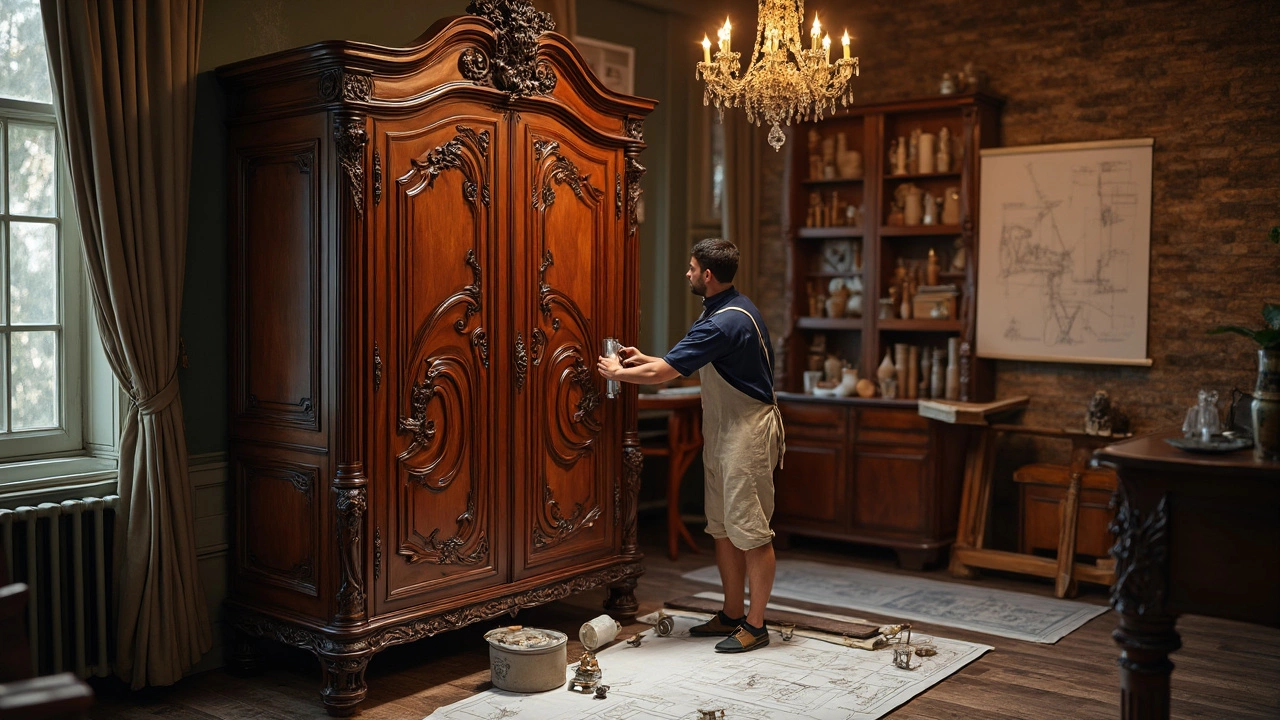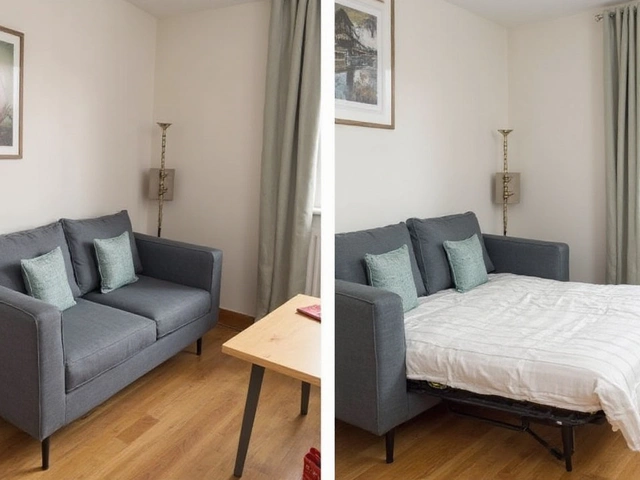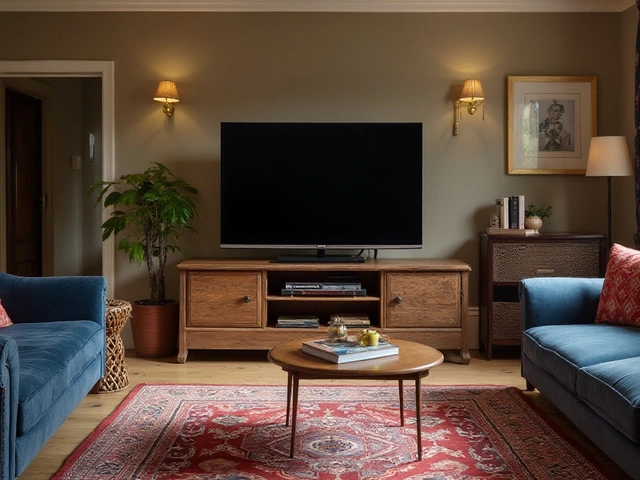Ever wonder why an armoire can set you back a pretty penny? You're not alone. Let's jump right into what's going on here. First off, it starts with the materials. Top-quality armoires often use solid wood like oak, cherry, or mahogany. These aren't just fancy words—these woods are durable, look good, and naturally cost more. Cheaper options use plywood or particleboard, so keep your eyes peeled if you're looking for long-lasting use.
Then there's the craftsmanship. If you're buying an armoire with intricate carvings or a unique design, you're paying for the artist's skilled hands. This level of work is often done by hand, requiring a craftsman with years of experience. It's not easy to replicate that kind of quality in mass-produced furniture.
Another factor is production and labor costs. Building a high-quality armoire isn't something you can rush. It takes time and skilled labor, which doesn't come cheap. Factories that prioritize ethical labor practices and environmentally-friendly processes may also add to the cost, but it's often worth supporting these practices.
- Material Quality
- Craftsmanship and Design
- Production and Labor Costs
- Market Demand
- Investment Value
- Tips for Buying an Armoire
Material Quality
When it comes to armoires, the type of material used is a big part of the cost. High-end armoires usually use solid hardwoods, like oak, mahogany, and cherry. These woods are not only durable but also have a natural beauty, making your armoire stand out as an elegant piece.
Types of Wood
Solid oak is known for its strength and wear resistance. This wood can handle a lot, which is why it's often seen in older furniture that's still going strong.
Mahogany has a classic appeal with its deep, rich color and smooth texture. It’s a go-to for finer furniture, giving your wardrobe a distinctly upscale vibe.
Cherry wood, on the other hand, ages into a deeper color over time, which many find appealing for its evolving character.
Alternative Materials
While the high price of solid wood is justified, there are cheaper alternatives like plywood or particleboard used in less expensive furniture options. These materials are usually covered with a veneer to imitate real wood. However, they don't match the durability or aesthetics of their hardwood counterparts.
Environmental Factors
Sustainability also affects material choice. Environmentally-conscious manufacturers often source wood from responsibly managed forests, ensuring lower environmental impact, which can slightly hike up the cost but supports good practices.
Here's a simple breakdown:
| Material Type | Durability | Cost |
|---|---|---|
| Solid Oak | High | Expensive |
| Mahogany | Medium to High | Expensive |
| Cherry | Medium | Moderate |
| Plywood | Low | Affordable |
| Particleboard | Low | Cheap |
When choosing an armoire, think about how often you'll use it and how long you want it to last. Poor quality materials might save you money initially but could cost more in repairs or replacements down the line.
Craftsmanship and Design
When it comes to armoires, craftsmanship and design are everything. An armoire isn't just furniture; it's like a piece of art. What many don't realize is the time and skill that goes into designing one.
Detailed Craftsmanship
An expertly crafted armoire might feature ornate carvings or inlays, which are done by hand in many high-end pieces. This isn't just anyone's job—it's up to seasoned artisans who have spent years perfecting their skills. The attention to detail is incredible, making each piece unique. This kind of artwork takes serious time, which, as you might guess, adds to the price.
Design Aesthetic
Design doesn't just stop at the outside; it's also about functionality. A well-designed armoire will blend practicality with style. The arrangement of shelves, drawers, and hanging spaces should cater to actual needs, offering smart solutions while keeping it chic. Different styles, like French provincial or modern minimalist, cater to various tastes, but all require a designer’s touch to get just right.
Beyond style, the design process also weaves in structural integrity. An armoire should stand the test of time, both aesthetically and structurally, which makes design choices critical.
The Custom Factor
Customization can be another factor. Many manufacturers offer options to tweak designs, from the type of wood to the color of the finish. Custom elements can set your armoire apart, but they also mean more labor and planning, which isn't free.
In a world filled with flat-packed furniture, the detailed craftsmanship and thoughtful design of a quality armoire are what make it stand out—and it's a key reason why they're priced the way they are.
Production and Labor Costs
Alright, let's talk about why these armoires often hit the high price mark due to production and labor costs. Making an armoire isn't just about slapping together some wood and calling it a day. Quality pieces require a lot of skilled hands and time-consuming processes. Factories that produce top-notch armoires often have highly trained craftsmen who devote hours to ensuring every detail is perfect.
Here's the thing: quality craftsmanship takes time and a certain level of expertise. This means paying skilled workers higher wages. Who are these folks? Well, you might find cabinetmakers and woodworkers who have spent years fine-tuning their skills. Their work ensures that every joint is perfect, and every surface is sanded just right.
Ethical Practices
Many companies pay more for ethical labor practices. This includes fair wages, good working conditions, and often sustainable materials. These costs are passed on to the consumer, but you're buying more than just an item — you're supporting fair labor practices.
Manufacturing Process
The manufacturing process itself can also hike up costs. Cutting, assembling, painting, and finishing - each step requires precision and care. Factories with modern technology may speed up the process but don't necessarily cut corners in terms of quality. Even with modernization, a lot relies on human skill.
| Production Step | Time Required (Hours) |
|---|---|
| Cutting and Assembly | 20 |
| Painting/Finishing | 15 |
| Quality Inspection | 5 |
A big chunk of the price tag is due to these production efforts. While it might feel like a heavy investment, the durability and beauty of a well-crafted armoire could last you a lifetime, making it worth every penny.

Market Demand
So, why exactly does demand play such a big role in the price of armoires? Well, it's all about supply and demand in the furniture world. When more people want a stylish, high-quality piece of furniture, manufacturers know they can charge more—and that's what they do.
Why Are Armoires So Popular?
These days, people want more than just a place to store clothes. An armoire can add an element of design to a room, acting like a functional piece of art. Many folks look for furniture that makes a statement, and an armoire certainly fits that bill. Plus, with the increasing popularity of open-concept living spaces, people are searching for pieces that provide both storage and aesthetic appeal.
The Investment Angle
Some people think of an armoire as an investment. Good ones tend to hold their value pretty well, especially if they're made from solid wood and have unique craftsmanship. As more people catch on to this idea, demand—and prices—tend to rise.
Seasonal Trends
Believe it or not, certain times of year can also impact furniture cost. Manufacturers often release new collections in the spring and fall, and the buzz around these launches can lead to increased demand and higher prices. If you're looking to snag a deal, keep an eye on off-season sales, which often occur in late winter and summer.
Here's a quick look at how seasonal trends might influence demand:
| Season | Demand Trend |
|---|---|
| Spring | High |
| Summer | Moderate |
| Fall | High |
| Winter | Low |
Understanding these trends can help you make a better purchasing decision when you're ready to buy.
Investment Value
Let's talk money. Armoires might have a higher price tag, but looking at them as an investment can ease the sticker shock. If you pick a classic design made from solid wood, you've got yourself a piece of furniture built to last. Style trends round the circle every decade or so, and a good armoire often holds its grace year after year.
Think of your favorite steamer trunk found in an antique store. Its price didn't dip over the years—in fact, it probably went up. That's the kind of potential an armoire has. Well-constructed pieces made from quality materials tend to maintain, if not increase, their value over time, especially as they age and become scarcer. They're often a wise choice for collectors or anyone thinking of future resale.
But what exactly makes these pieces valuable long-term? First, it's uniqueness and artistry. Skilled craftsmanship can make an armoire not just a storage solution but an eye-catching centerpiece. If you're thinking ahead, look for pieces with distinctive carvings or finishes—they tend to be more sought after.
The Role of Rarity
Armoires aren't churned out as rapidly as flat-pack furniture, making them a rarer find. If you're patient, look for models with limited production runs or custom features. These often fetch a premium later when you decide to sell or pass them down.
A high-quality armoire doesn't just sit—it grows on you and potentially in value. Next time you grimace at the price, remember, it's not just another expense. It's a future asset. And that might make it worth every penny.
Tips for Buying an Armoire
So you're in the market for an armoire and trying to make a smart purchase without feeling overwhelmed? Good news—there's a way to approach this without losing your mind or your wallet! Here are some practical tips to guide you on your quest to find the perfect piece of furniture.
1. Define Your Needs
First things first—what do you need this wardrobe for? Is it just to store clothes, or do you need space for shoes and accessories as well? Identifying your needs will help you select an armoire that fits your lifestyle.
2. Understand Your Space
Before falling in love with a gigantic armoire, measure your available space. You don't want to end up with a piece that's either too small or too large for your room. Keep in mind that you’ll need space to open drawers and doors comfortably as well.
3. Consider Material and Build Quality
It's tempting to go for the cheapest option, but there's a reason why solid wood pieces are pricey—they last! If you’ve got pets or children, durability should be a top priority. High-quality materials like oak or cherry not only last longer but also add a touch of elegance to your room.
4. Set a Budget
Establish how much you're willing to spend. Set a range rather than an exact number to provide some flexibility. Remember, a quality armoire is a long-term investment, so if you find a piece that's slightly above your budget but checks all the boxes, it might be worth it.
5. Look for Sales and Discounts
Stores often have periodic sales where you can snag an expensive armoire at a reasonable price. Online retailers might offer promo codes, so a bit of sleuthing can really pay off. Don't forget to check out second-hand options; often you can find gently used armoires in excellent condition.
6. Check Reviews and Ratings
Before committing, read reviews from other buyers. This can provide insights you might not have considered, such as ease of assembly or real-life durability. A quick search could prevent buyer's remorse later on.
7. Consider Future Needs
Sure, today you just want a wardrobe. But what if you need adjustable shelves or more hanging space in a few years? Opt for an armoire that's versatile enough to adapt to your future needs.
Remember, shopping for armoires is more than just a transaction—it's an investment in your home. Make sure you choose a piece that you'll love for years to come!



